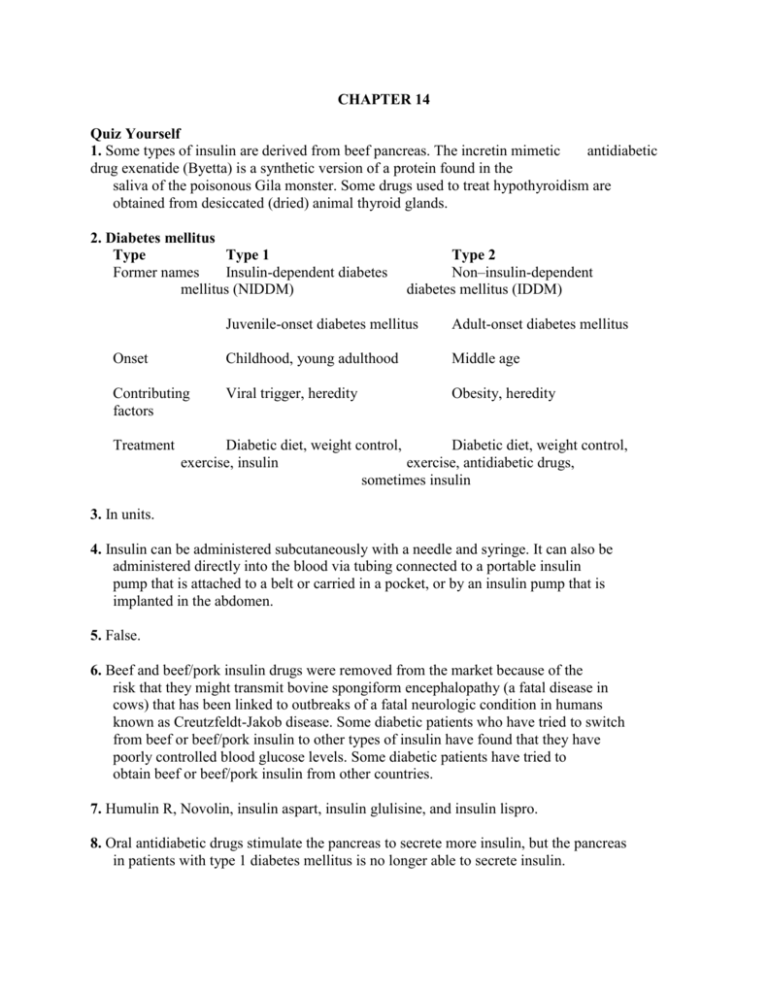CHAPTER 14 Quiz Yourself 1. Some types of insulin are derived
advertisement

CHAPTER 14 Quiz Yourself 1. Some types of insulin are derived from beef pancreas. The incretin mimetic antidiabetic drug exenatide (Byetta) is a synthetic version of a protein found in the saliva of the poisonous Gila monster. Some drugs used to treat hypothyroidism are obtained from desiccated (dried) animal thyroid glands. 2. Diabetes mellitus Type Type 1 Former names Insulin-dependent diabetes mellitus (NIDDM) Type 2 Non–insulin-dependent diabetes mellitus (IDDM) Juvenile-onset diabetes mellitus Adult-onset diabetes mellitus Onset Childhood, young adulthood Middle age Contributing factors Viral trigger, heredity Obesity, heredity Treatment Diabetic diet, weight control, Diabetic diet, weight control, exercise, insulin exercise, antidiabetic drugs, sometimes insulin 3. In units. 4. Insulin can be administered subcutaneously with a needle and syringe. It can also be administered directly into the blood via tubing connected to a portable insulin pump that is attached to a belt or carried in a pocket, or by an insulin pump that is implanted in the abdomen. 5. False. 6. Beef and beef/pork insulin drugs were removed from the market because of the risk that they might transmit bovine spongiform encephalopathy (a fatal disease in cows) that has been linked to outbreaks of a fatal neurologic condition in humans known as Creutzfeldt-Jakob disease. Some diabetic patients who have tried to switch from beef or beef/pork insulin to other types of insulin have found that they have poorly controlled blood glucose levels. Some diabetic patients have tried to obtain beef or beef/pork insulin from other countries. 7. Humulin R, Novolin, insulin aspart, insulin glulisine, and insulin lispro. 8. Oral antidiabetic drugs stimulate the pancreas to secrete more insulin, but the pancreas in patients with type 1 diabetes mellitus is no longer able to secrete insulin. 9. The sulfonylurea category of oral antidiabetic drugs stimulates the pancreas to produce more insulin. The meglitinide category of oral antidiabetic drugs stimulates the beta cells of the pancreas to produce more insulin. The thiazolidinedione category of oral antidiabetic drugs increases the sensitivity of the cell to any insulin produced by the pancreas and suppresses the release of stored glucose from the liver. The alpha-glucosidase inhibitor category of oral antidiabetic drugs inhibits the action of certain enzymes that digest carbohydrates. The biguanide category of oral antidiabetic drugs decreases the absorption of glucose from the intestine, suppresses the release of stored glucose from the liver, and improves the ability of cells to use the insulin that is produced by the pancreas. The DPP-4 inhibitor category of oral antidiabetic drugs prolongs the action of the hormones GLP-1 and GIP that stimulate the beta cells of the pancreas to make more insulin. The amylin analog category of antidiabetic drugs slows the rate at which food leaves the stomach, suppresses the release of stored glucose from the liver, and works in the brain to decrease the appetite. The incretin mimetic category of antidiabetic drugs stimulates the beta cells of the pancreas to produce insulin only when blood glucose level is high. 10. liotrix (Thyrolar). 11. [Only need to name four.] Cytomel, Triostat, Levothroid, Synthroid, Armour Thyroid, Thyrolar. 12. Growth hormone replacement drugs are used to treat children with failure to grow. Drugs that decrease the production of growth hormone are used to treat adults with acromegaly. 13. The adrenal cortex secretes the two powerful, anti-inflammatory hormones and cortisol. hydrocortisone 14. Patients who take prolonged or high doses of a corticosteroid drug such as prednisone develop increased deposition of fat in the face (moon face) and back of the neck (buffalo hump); they have a thinning of facial connective tissue which allows the blood vessels to show through, giving their cheeks a reddened appearance; they also have increased blood sugar levels, as well as wasting of the muscles of the extremities and weakness from depressed protein synthesis. 15. Anabolic steroid drugs are prescribed to counteract the loss of muscle mass and strength that occurs with AIDS wasting syndrome, to promote weight gain following extensive surgery or trauma, to increase the RBC count and treat anemia, or to increase muscle mass in patients with muscular dystrophy. Oxandrolone is also used to treat bone pain in patients with osteoporosis and to treat a lack of growth in patients with Turner syndrome. Anabolic steroid drugs are used to increase muscle mass, strength, and endurance. This is illegal in amateur and professional sports competitions, and can cause decreased sperm count, shrunken testicles, baldness, and irreversible breast enlargement in men, and baldness and excessive growth of facial hair in women. Other serious side effects of anabolic steroid drugs include aggressive behavior, atherosclerosis, and even liver cancer. 16. a. Diabetes mellitus type 1 b. Diabetes mellitus type 2 c. Hypothyroidism d. Addison’s disease e. Diabetes mellitus type 2 f. Lack of growth in children g. Diabetes mellitus type 2 h. Diabetes insipidus i. Hypothyroidism j. Diabetes mellitus type 2 Clinical Applications Questions 1. a. Synthroid b. 25 mcg c. Take this medicine on an empty stomach. Take this medicine with a full glass of water. Take this medicine in the morning. Take this medication at least four hours before taking antacids, iron, or vitamin/ mineral supplements. Take or use this medicine exactly as directed. Do not skip doses or discontinue unless directed by your doctor. d. 30 e. Lannett f. 11/06/07 g. 11 h. Sig: 1 tab PO q.d. 2. Synthroid 0.125 milligram tablet. 60 tablets. Take 1 every morning 1 hour before breakfast. Refills: 1. 3. DiaBeta







